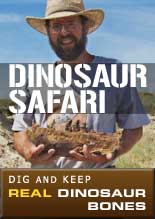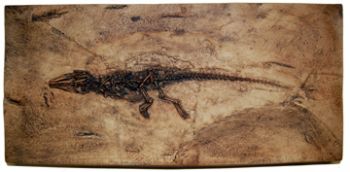
Diplocynodon is an extinct 49 million year old crocodile from the Messel Formation of Germany. The Order Crocodilia has existed for about 200 million years. It is believed that crocodiles originated from bipedal reptiles that lived during the Late Triassic Period. Crocodiles are the only surviving members of the Superorder Archosauria which included dinosaurs and pterasaurs. Crocodiles have changed very little throughout their history. There are eight surviving genera of Crocodilians alive today. At the Messel quarry in Germany, six distinct genera of Crocodilians can be recognized. This replica represents the Genus Diplocynodon. There were two species of Diplocynodon at Messel (D. darwini, and D. ebertsi) but this individual was a juvenile making species identification nearly impossible.
Diplocynodon was very similar to the modern Caimen. It had bony armor scutes covering its neck, back, belly, and part of the tail. The largest Diplocynodon specimens recovered at Messel reach lengths of about 4 feet. Diplocynodon fed on fish and animal flesh, but probably took smaller prey such as insects as a juvenile
The Messel quarry, near Frankfurt, Germany is world renowned for the near-perfect preservation of the fossils that it yields. For over 100 years the Messil site had been mined for its oil shale, or "brown coal" as it is commonly called. About 49 million years ago, during the Middle Eocene Epoch, the Messel area was a swampy fresh water lake environment with a rich and diverse flora and fauna. Seasonal blooms of algae in the lakes at Messel would cause the water to be foul and stagnant. If an animal died and fell into the water, its carcass could lay unscavanged and undisturbed in the oxygen-depleted lake bottom. A fine mist of dead algae would cover the organism and preserve it in fine layers of shale. The result is unparalleled preservation of things seldom preserved such as fur, feathers, and gut contents. The Messel quarry offers a nearly complete glimpse of the ancient Messel environment and the animals, birds, reptiles, amphibians, fish, insects, and plants that inhabited Germany 49 million years ago.
High Density Polyurethane
15.1 x 7.25x 1 inches
Item 1179
Category: Replicas
Type: Skeletons
Phylum: Vertebrates
Class: Reptiles
MORE PHOTOS:
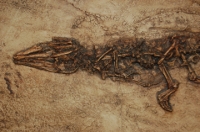
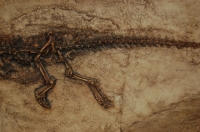
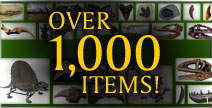
Now Over 1,000 Items!
PrehistoricStore.com offers the largest selection of replica fossils and other fossil-related products anywhere in the world!
Download a Full Catalog (3MB PDF)
OVER 260 PAGES OF REPLICAS AND MORE!
